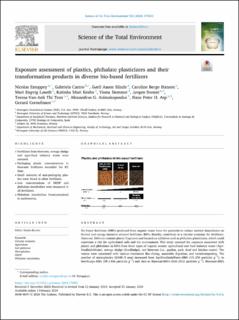| dc.contributor.author | Estoppey, Nicolas | |
| dc.contributor.author | Varela, Gabriela Castro | |
| dc.contributor.author | Slinde, Gøril Aasen | |
| dc.contributor.author | Hansen, Caroline Berge | |
| dc.contributor.author | Løseth, Mari Engvig | |
| dc.contributor.author | Krahn, Katinka Muri | |
| dc.contributor.author | Demmer, Viona | |
| dc.contributor.author | Svenni, Jørgen | |
| dc.contributor.author | Tran, Teresa-Van-Anh Thi | |
| dc.contributor.author | Asimakopoulos, Alexandros | |
| dc.contributor.author | Arp, Hans Peter Heinrich | |
| dc.contributor.author | Cornelissen, Gerard | |
| dc.date.accessioned | 2024-04-16T08:26:00Z | |
| dc.date.available | 2024-04-16T08:26:00Z | |
| dc.date.created | 2024-02-26T11:08:00Z | |
| dc.date.issued | 2024 | |
| dc.identifier.citation | Science of the Total Environment. 2024, 918 . | en_US |
| dc.identifier.issn | 0048-9697 | |
| dc.identifier.uri | https://hdl.handle.net/11250/3126703 | |
| dc.description.abstract | Bio-based fertilizers (BBFs) produced from organic waste have the potential to reduce societal dependence on limited and energy-intensive mineral fertilizers. BBFs, thereby, contribute to a circular economy for fertilizers. However, BBFs can contain plastic fragments and hazardous additives such as phthalate plasticizers, which could constitute a risk for agricultural soils and the environment. This study assessed the exposure associated with plastic and phthalates in BBFs from three types of organic wastes: agricultural and food industry waste (AgriFoodInduWaste), sewage sludge (SewSludge), and biowaste (i.e., garden, park, food and kitchen waste). The wastes were associated with various treatments like drying, anaerobic digestion, and vermicomposting. The number of microplastics (0.045–5 mm) increased from AgriFoodInduWaste-BBFs (15–258 particles g−1), to SewSludge-BBFs (59–1456 particles g−1) and then to Biowaste-BBFs (828–2912 particles g−1). Biowaste-BBFs mostly contained packaging plastics (e.g., polyethylene terephthalate), with the mass of plastic (>10 g kg−1) exceeding the EU threshold (3 g kg−1, plastics >2 mm). Other BBFs mostly contained small (< 1 mm) non-packaging plastics in amounts below the EU limit. The calculated numbers of microplastics entering agricultural soils via BBF application was high (107–1010 microplastics ha−1y−1), but the mass of plastic released from AgriFoodInduWaste-BBFs and SewSludge-BBFs was limited (< 1 and <7 kg ha−1y−1) compared to Biowaste-BBFs (95–156 kg ha−1y−1). The concentrations of di(2-ethylhexyl)phthalate (DEHP; < 2.5 mg kg−1) and phthalate transformation products (< 8 mg kg−1) were low (< benchmark of 50 mg kg−1 for DEHP), attributable to both the current phase-out of DEHP as well as phthalate degradation during waste treatment. The Biowaste-BBF exposed to vermicomposting indicated that worms accumulated phthalate transformation products (4 mg kg−1). These results are overall positive for the implementation of the studied AgriFoodInduWaste-BBFs and SewSludge-BBFs. However, the safe use of the studied Biowaste-BBFs requires reducing plastic use and improving sorting methods to minimize plastic contamination, in order to protect agricultural soils and reduce the environmental impact of Biowaste-BBFs. | en_US |
| dc.language.iso | eng | en_US |
| dc.publisher | Elsevier | en_US |
| dc.rights | Navngivelse 4.0 Internasjonal | * |
| dc.rights.uri | http://creativecommons.org/licenses/by/4.0/deed.no | * |
| dc.title | Exposure assessment of plastics, phthalate plasticizers and their transformation products in diverse bio-based fertilizers | en_US |
| dc.title.alternative | Exposure assessment of plastics, phthalate plasticizers and their transformation products in diverse bio-based fertilizers | en_US |
| dc.type | Peer reviewed | en_US |
| dc.type | Journal article | en_US |
| dc.description.version | publishedVersion | en_US |
| dc.source.pagenumber | 0 | en_US |
| dc.source.volume | 918 | en_US |
| dc.source.journal | Science of the Total Environment | en_US |
| dc.identifier.doi | 10.1016/j.scitotenv.2024.170501 | |
| dc.identifier.cristin | 2249709 | |
| cristin.ispublished | true | |
| cristin.fulltext | original | |
| cristin.qualitycode | 2 | |

